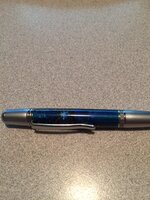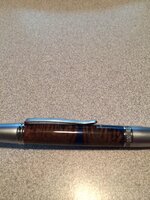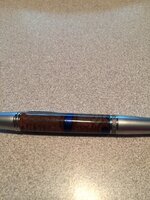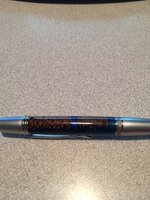Patio
Member
I am new to casting and after researching and reading on the different resins and experiences everyone has had on here plus watching the videos that Curtis has made, I decided to use Alumilite.
I created my molds and made up a casting last night using alumilite water clear with some blue dye and pearl mixed in. I liked the color a lot and poured into my mold and put in pressure pot at 70lbs for about an hour.
After I releaseed the pressure on the pot and took out my mold, I noticed the resin was still soft.
I had a little bit of resin left over in my cup and I had stirred it a while looking at how the pearl coloring appeared in the light. That resin hardened to a rock and it wasn't ever in the pressure pot.
My question is what are the things that could cause that resin not to harden properly? Did I not stir it up well enough? I stirred it until it was all clear with no swirls and then stirred for about another minute, then added the dye and pearl and mixed that in as well (actually pearl was last and swirled it). In all I would say that I had a little over 3 minutes of stirring time.
Is it possible that I'm introducing moisture from my air compressor? What is the shelf life of the resin? I've had this resin for about 6 months.
Anyway, I left the resin overnight in the mold and took it out this morning. Its hardened but not as hard as I think it should be. I was able to cut it into blanks and it seems to be just fine and seem to have hardened a bit more since cutting into blank sizes.
Thanks everyone!
Pat
I created my molds and made up a casting last night using alumilite water clear with some blue dye and pearl mixed in. I liked the color a lot and poured into my mold and put in pressure pot at 70lbs for about an hour.
After I releaseed the pressure on the pot and took out my mold, I noticed the resin was still soft.
I had a little bit of resin left over in my cup and I had stirred it a while looking at how the pearl coloring appeared in the light. That resin hardened to a rock and it wasn't ever in the pressure pot.
My question is what are the things that could cause that resin not to harden properly? Did I not stir it up well enough? I stirred it until it was all clear with no swirls and then stirred for about another minute, then added the dye and pearl and mixed that in as well (actually pearl was last and swirled it). In all I would say that I had a little over 3 minutes of stirring time.
Is it possible that I'm introducing moisture from my air compressor? What is the shelf life of the resin? I've had this resin for about 6 months.
Anyway, I left the resin overnight in the mold and took it out this morning. Its hardened but not as hard as I think it should be. I was able to cut it into blanks and it seems to be just fine and seem to have hardened a bit more since cutting into blank sizes.
Thanks everyone!
Pat




